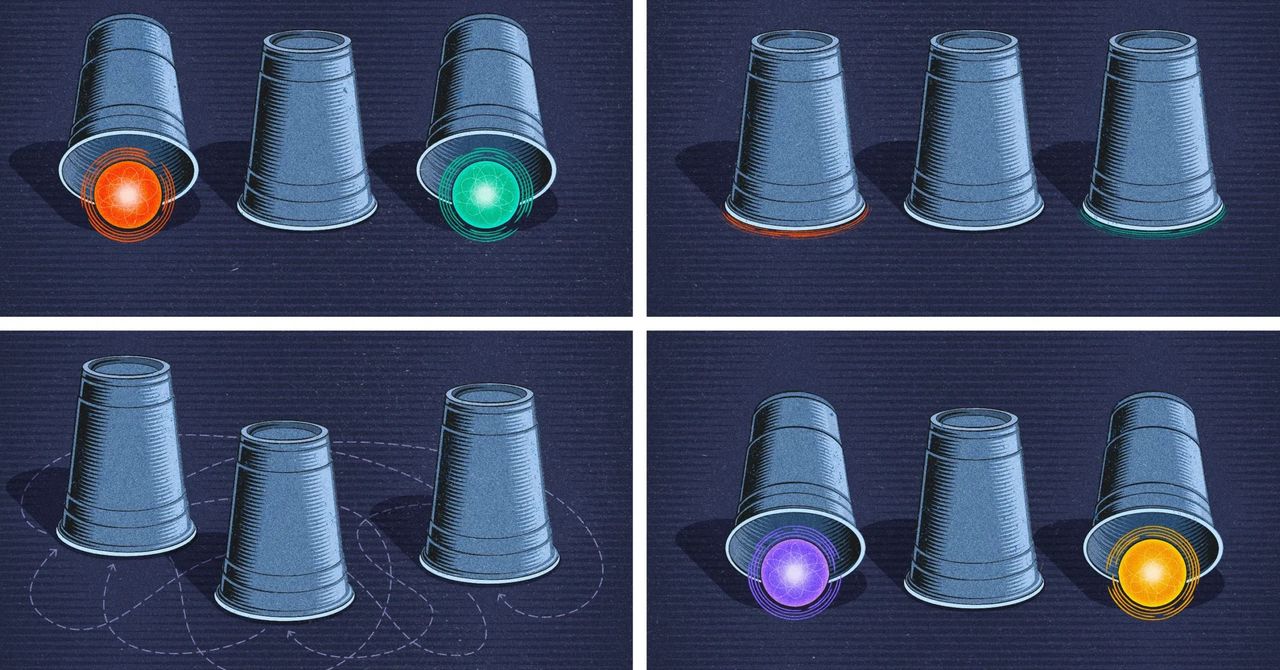When you swap two paraparticles, these hidden properties change in tandem. As an analogy, imagine that these properties are colors. Start with two paraparticles, one that’s internally red and another that’s internally blue. When they swap places, rather than keeping these colors, they both change in corresponding ways, as prescribed by the mathematics of the particular model. Perhaps the swap leaves them green and yellow. This quickly turns into a complex game, where paraparticles affect each other in unseen ways as they move around.
Meanwhile, Müller was also busy rethinking the DHR theorems. “It’s not always super transparent what they mean, because it’s in a very complicated mathematical framework,” he said.
His team took a new approach to the paraparticle question. The researchers considered the fact that quantum systems can exist in multiple possible states at once—what’s called a superposition. They imagined switching between the perspectives of observers who exist in these superposed states, each of whom describes their branch of reality slightly differently. If two particles are truly indistinguishable, they figured, then it won’t matter if the particles are swapped in one branch of the superposition and not in the other.
“Maybe if the particles are close by, I swap them, but if they are far away I do nothing,” Müller said. “And if they’re in a superposition of both, then I do the swapping in one branch, and nothing in the other branch.” Whether observers across branches label the two particles in the same way should make no difference.
This stricter definition of indistinguishability in the context of superpositions imposes new restrictions on the kinds of particles that can exist. When these assumptions hold, the researchers found that paraparticles are impossible. For a particle to be truly indistinguishable by measurement, as physicists expect elementary particles to be, it must be either a boson or fermion.
Although Wang and Hazzard published their paper first, it’s as though they saw Müller’s constraints coming. Their paraparticles are possible because their model rejects Müller’s starting assumption: The particles are not indistinguishable in the full sense required in the context of quantum superpositions. This comes with a consequence. While swapping two paraparticles has no effect on one person’s measurements, two observers, by sharing their data with each other, can determine whether the paraparticles have been swapped. That’s because swapping paraparticles can change how two people’s measurements relate to each other. In this sense, they could tell the two paraparticles apart.
This means there’s a potential for new states of matter. Where bosons can pack an endless number of particles into the same state, and fermions can’t share a state at all, paraparticles end up somewhere in the middle. They are able to pack just a few particles into the same state, before getting crowded and forcing others into new states. Exactly how many can be crammed together depends on the details of the paraparticle—the theoretical framework allows for endless options.
“I find their paper really fascinating, and there’s absolutely no contradiction with what we do,” Müller said.
The Road to Reality
If paraparticles exist, they’ll most likely be emergent particles, called quasiparticles, that show up as energetic vibrations in certain quantum materials.
“We might get new models of exotic phases, which were difficult to understand before, that you can now solve easily using paraparticles,” said Meng Cheng, a physicist at Yale University who was not involved in the research.
Bryce Gadway, an experimental physicist at Pennsylvania State University who sometimes collaborates with Hazzard, is optimistic that paraparticles will be realized in the lab in the next few years. These experiments would use Rydberg atoms, which are energized atoms with electrons that roam very far from their nuclei. This separation of the positive and negative charge makes Rydberg atoms especially sensitive to electric fields. You can build quantum computers out of interacting Rydberg atoms. They are also the perfect candidates for creating paraparticles.
“For a certain kind of Rydberg quantum simulator, this is kind of just what they would do naturally,” Gadway said about creating paraparticles. “You just prepare them and watch them evolve.”
But for now, the third kingdom of particles remains wholly theoretical.
“Paraparticles might become important,” said Wilczek, the Nobel Prize–winning physicist and inventor of anyons. “But at present they’re basically a theoretical curiosity.”
Original story reprinted with permission from Quanta Magazine, an editorially independent publication of the Simons Foundation whose mission is to enhance public understanding of science by covering research developments and trends in mathematics and the physical and life sciences.








